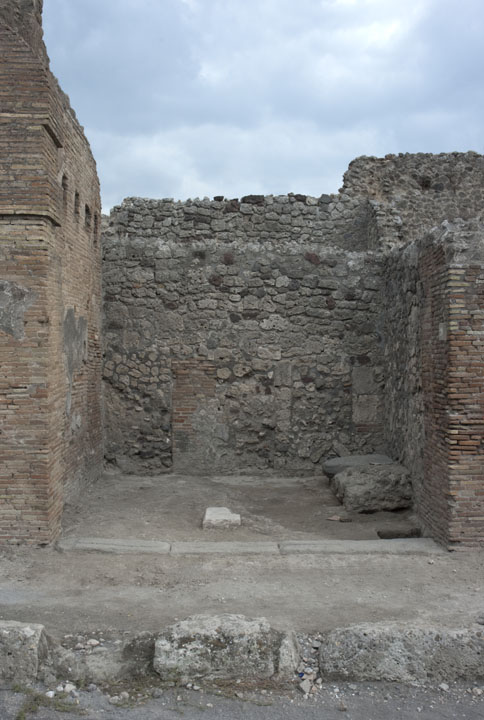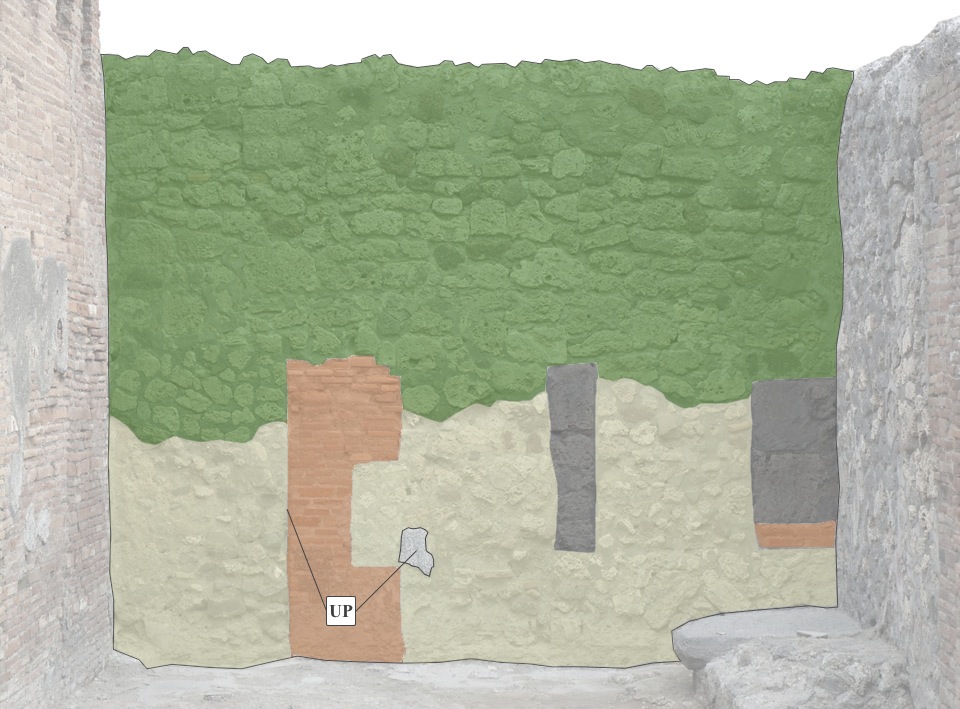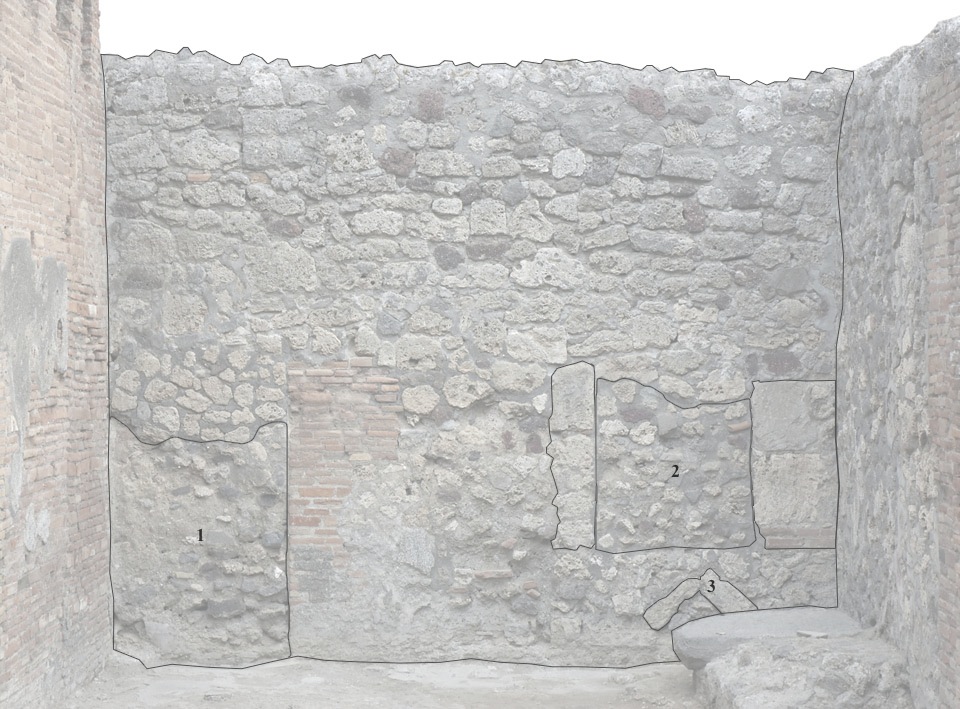East Wall
Description
Mats Holmlund
The wall is circa 4.00 m wide, 3.20 m high in the north corner and 3.00 m high in the south corner. It consists of two main parts. The first part stretches from the north to the south corner, and from the floor level up to circa 1.25 to 1.60 m from the ground. The second part also spans the entire width of the wall, but begins circa 1.25 to 1.60 m from the ground and ends at the top of the wall.
The first part of the wall consists of four separate segments. The first segment is located in the north corner, is circa 1.00 m wide and 1.25 to 1.35 m high, and is constructed in opus incertum. The second segment is juxtaposed to the first, it is approximately 0.60 to 0.65 m wide and 1.55 m high, and built in opus testaceum. The third consists of the middle part of the wall and the remainder of the lower part of the wall, it is circa 2.40 m wide and 1.40 m high at its highest point, and is built in opus incertum. The fourth segment starts at the south corner and 0.65 m from the floor level. It is circa 1.60 m wide and up to 1.05 m high at its highest point and, built in opus quadratum, opus incertum and opus testaceum.
The second (upper) part of the wall was reconstructed in modern times.
There are a couple of features in the wall. The first is a closed door (the first segment of the lower part of the wall) that originally led into room f of house V.1,28 (Casa di Tofelanus Valens). It was blocked off in antiquity and is filled with stones and mortar. The fill consists of lava, limestone, cruma, tufa, and some spolia. The closed door is defined, to the north, by the corner of the wall, and to the south, by a doorpost built in opus testaceum. The doorpost is 0.60 to 0.65 m wide and "crenelated" in the back. Between 0.35 to 0.95 m from the floor level, it is only 0.35 m wide. The individual tiles of the doorpost vary in size from 0.04 to 0.24 m wide and 0.03 to 0.07 m high. They also vary in colour from beige and yellowish to terracotta and brownish orange. Some tiles are unevenly burnt and have a grey strand in the middle of them.
In the south corner, circa 0.65 m from the floor level, there is a closed window. Like the closed door, opened into room f of house V.1,28. Two frames define the window. The northern frame is constructed in opus quadratum, and consists of three limestone blocks stacked on top of each other. The first block is 0.22 wide and 0.32 m high, the second 0.24 m wide and 0.32 m high, and the third 0.25 m wide and 0.37 m high. The southern frame is built in opus quadratum and opus testaceum. It consists of a tufa block, stacked on top of a limestone block that is stacked upon two rows of tiles. The limestone block measure 0.42 x 0.40 m and the tufa block 0.35 x 0.38 m.
The window (the fill) is built in opus incertum and consists of limestone, lava, cruma, a piece of terracotta, and mortar.
Below the closed window, there is a rudimentary arch that consists of two limestone blocks tilted towards each other. The base of the arch starts circa 0.40 m from the south corner and 0.20 m from the floor level. It is approximately 0.65 m wide and 0.35 m high. The northern limestone block is 0.73 wide and 0.11 m high, and the southern 0.40 m wide and 0.15 m high.
There are a number of spolia in the wall. There are two pieces of coccio pesto floor in the closed door. The first is located circa 0.50 from the north corner and 0.50 m from the ground. The second is located circa 2.60 m from the north corner and 0.40 m from the ground. There is a piece of travertine located 0.95 m from the north corner and 0.30 m from the ground. There are a group of five terracotta tiles in an area located circa 1.90 m from the north corner and 0.20 m from the floor level. The area is approximately 0.50 m wide and 0.30 m high. The largest tile is 0.21 m wide and 0.04 m high. There are four pieces of reused mortar. The first is located 0.15 m from the north corner and 0.70 m from the ground, the second is 0.20 m from the north corner and 0.70 m from the ground, and the third is located 0.50 m from the north corner and 0.85 m from the ground. The fourth piece is located circa 2.10 m from the north corner and 1.10 m from the floor. Lastly, there is a slightly curved piece of terracotta, which looks like it could have been part of a rim of a large ceramics vessel, located circa 3.60 m from the north corner and 1.15 m from the ground.
The mortar of the lower part of the wall is yellowish grey and contains grains of lava and limestone, while the mortar of the upper (reconstructed) part is dark grey and contains grains of lava. Modern mortar has been applied to the crest of the wall to prevent the top stones from falling down.
There are two areas with remaining plaster on the wall. The first is located on the inside of the testaceum-part of the wall, between the closed door and the doorpost. The plaster stretches from the floor level up to circa 0.60m from the ground. The second area is located approximately 1.60 m from the north corner and 0.50 m from the floor level. It is circa 0.20 m wide and o.30 m high. The plaster of the first area is quite well preserved, but since only a small part of it is difficult to say anything more than that. The plaster of the second area is weathered and there are no decorations or traces of graffiti on it.



